CHCECE024: Theory Assessment on Curriculum Design and Implementation
VerifiedAdded on 2019/11/08
|24
|4352
|1344
Homework Assignment
AI Summary
This document presents a comprehensive solution to the CHCECE024 theory assessment, focusing on designing and implementing curricula to foster children's learning and development. The assignment covers various aspects, including designing a learning experience with detailed specifications for a 5-year-old child, incorporating developmental milestones, materials, setup, engagement strategies, modifications, and evaluation methods. It also addresses the importance of respecting Indigenous backgrounds, providing examples of incorporating culturally relevant materials. Furthermore, the assignment includes creating a learning environment plan, designing a family feedback survey, discussing methods for gathering child feedback, writing a detailed educational philosophy, and analyzing curriculum implementation methods. Finally, the document presents completed activity proformas, demonstrating a practical understanding of curriculum design principles and their application in early childhood education.
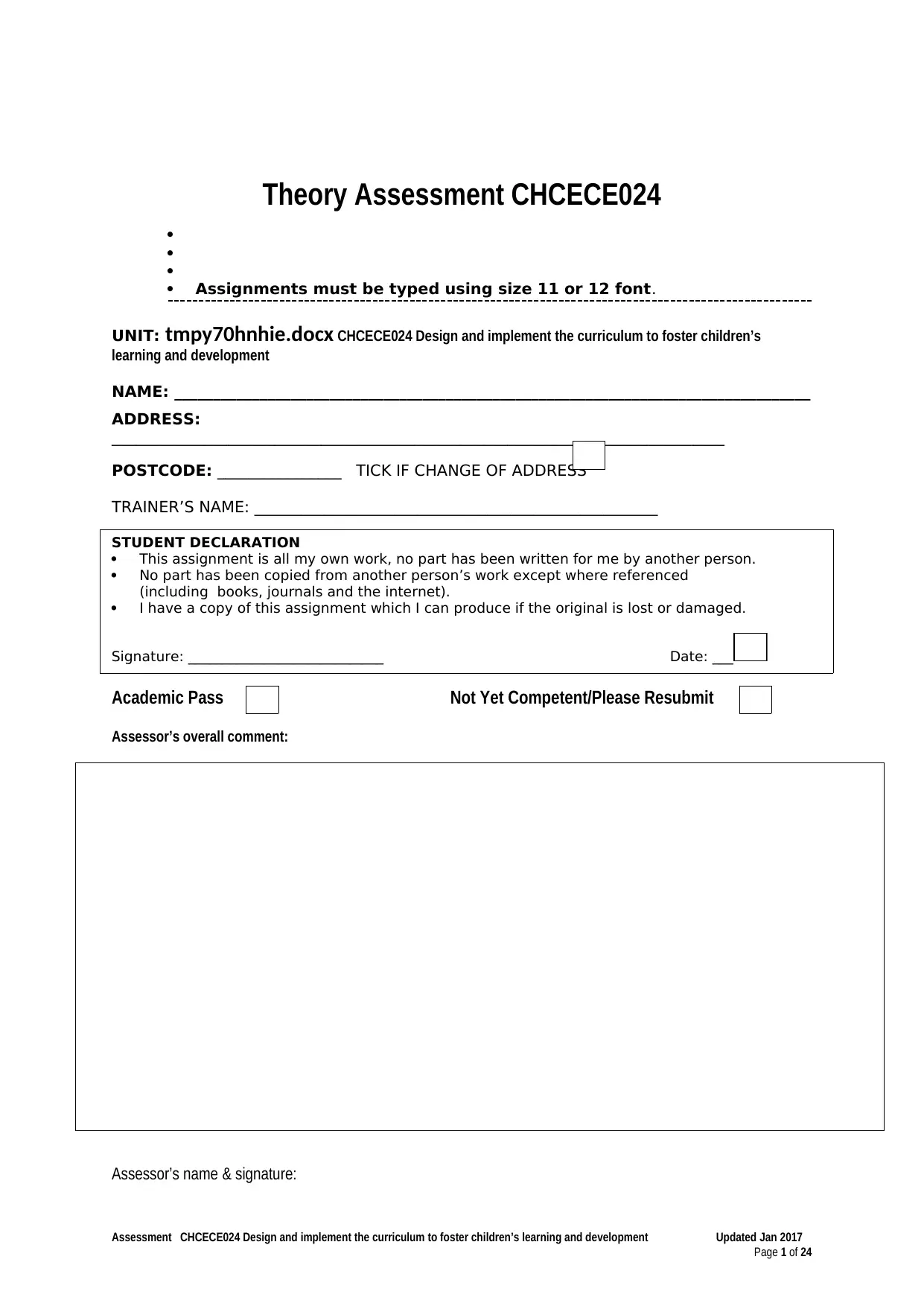
Theory Assessment CHCECE024
Assignments must be typed using size 11 or 12 font.
UNIT: tmpy70hnhie.docx CHCECE024 Design and implement the curriculum to foster children’s
learning and development
NAME: __________________________________________________________________________________
ADDRESS:
_______________________________________________________________________________
POSTCODE: ________________ TICK IF CHANGE OF ADDRESS
TRAINER’S NAME: ____________________________________________________
Academic Pass Not Yet Competent/Please Resubmit
Assessor’s overall comment:
Assessor’s name & signature:
Assessment CHCECE024 Design and implement the curriculum to foster children’s learning and development Updated Jan 2017
Page 1 of 24
STUDENT DECLARATION
This assignment is all my own work, no part has been written for me by another person.
No part has been copied from another person’s work except where referenced
(including books, journals and the internet).
I have a copy of this assignment which I can produce if the original is lost or damaged.
Signature: ____________________________ Date: ___
_________
Assignments must be typed using size 11 or 12 font.
UNIT: tmpy70hnhie.docx CHCECE024 Design and implement the curriculum to foster children’s
learning and development
NAME: __________________________________________________________________________________
ADDRESS:
_______________________________________________________________________________
POSTCODE: ________________ TICK IF CHANGE OF ADDRESS
TRAINER’S NAME: ____________________________________________________
Academic Pass Not Yet Competent/Please Resubmit
Assessor’s overall comment:
Assessor’s name & signature:
Assessment CHCECE024 Design and implement the curriculum to foster children’s learning and development Updated Jan 2017
Page 1 of 24
STUDENT DECLARATION
This assignment is all my own work, no part has been written for me by another person.
No part has been copied from another person’s work except where referenced
(including books, journals and the internet).
I have a copy of this assignment which I can produce if the original is lost or damaged.
Signature: ____________________________ Date: ___
_________
Paraphrase This Document
Need a fresh take? Get an instant paraphrase of this document with our AI Paraphraser
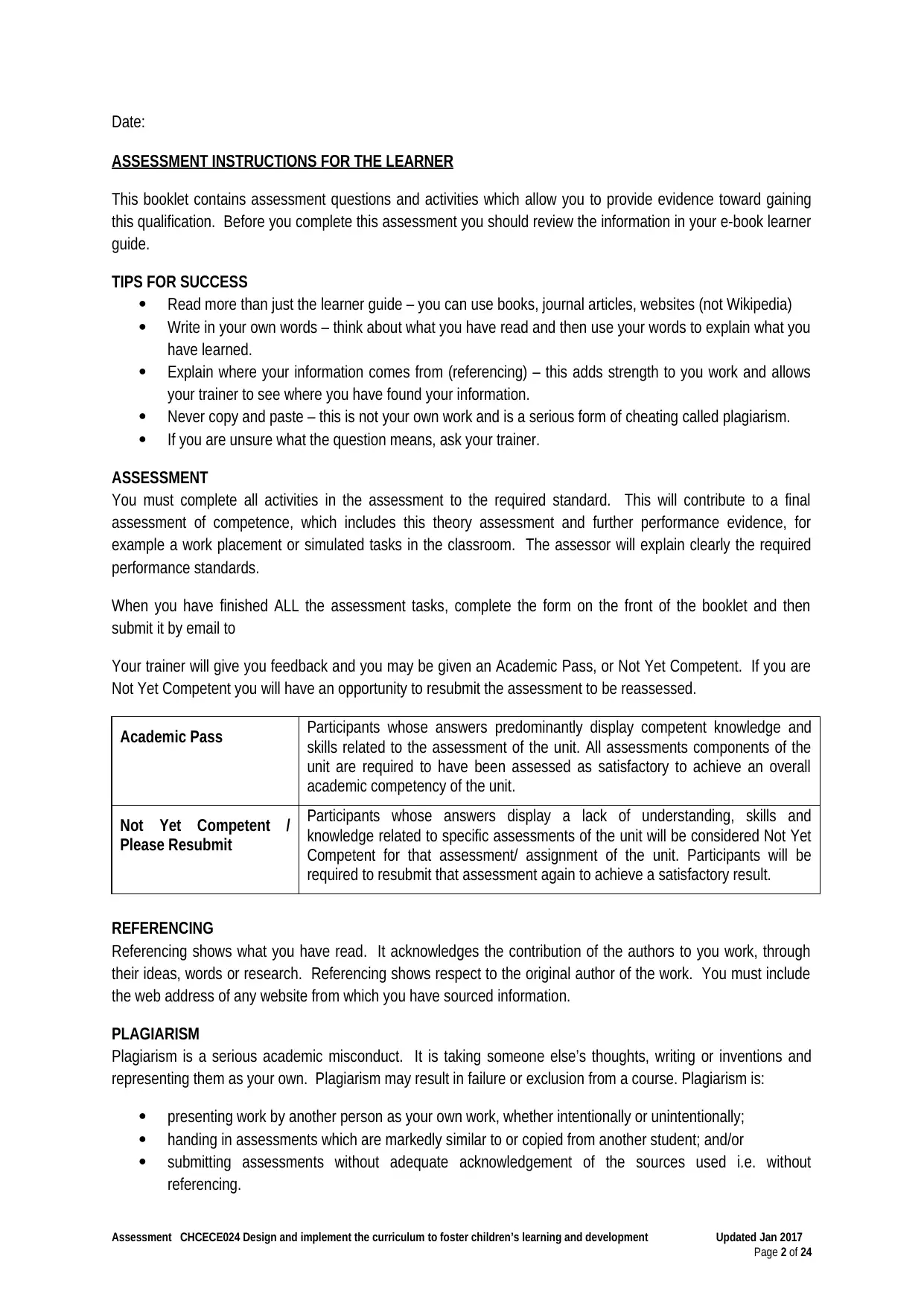
Date:
ASSESSMENT INSTRUCTIONS FOR THE LEARNER
This booklet contains assessment questions and activities which allow you to provide evidence toward gaining
this qualification. Before you complete this assessment you should review the information in your e-book learner
guide.
TIPS FOR SUCCESS
Read more than just the learner guide – you can use books, journal articles, websites (not Wikipedia)
Write in your own words – think about what you have read and then use your words to explain what you
have learned.
Explain where your information comes from (referencing) – this adds strength to you work and allows
your trainer to see where you have found your information.
Never copy and paste – this is not your own work and is a serious form of cheating called plagiarism.
If you are unsure what the question means, ask your trainer.
ASSESSMENT
You must complete all activities in the assessment to the required standard. This will contribute to a final
assessment of competence, which includes this theory assessment and further performance evidence, for
example a work placement or simulated tasks in the classroom. The assessor will explain clearly the required
performance standards.
When you have finished ALL the assessment tasks, complete the form on the front of the booklet and then
submit it by email to
Your trainer will give you feedback and you may be given an Academic Pass, or Not Yet Competent. If you are
Not Yet Competent you will have an opportunity to resubmit the assessment to be reassessed.
Academic Pass Participants whose answers predominantly display competent knowledge and
skills related to the assessment of the unit. All assessments components of the
unit are required to have been assessed as satisfactory to achieve an overall
academic competency of the unit.
Not Yet Competent /
Please Resubmit
Participants whose answers display a lack of understanding, skills and
knowledge related to specific assessments of the unit will be considered Not Yet
Competent for that assessment/ assignment of the unit. Participants will be
required to resubmit that assessment again to achieve a satisfactory result.
REFERENCING
Referencing shows what you have read. It acknowledges the contribution of the authors to you work, through
their ideas, words or research. Referencing shows respect to the original author of the work. You must include
the web address of any website from which you have sourced information.
PLAGIARISM
Plagiarism is a serious academic misconduct. It is taking someone else’s thoughts, writing or inventions and
representing them as your own. Plagiarism may result in failure or exclusion from a course. Plagiarism is:
presenting work by another person as your own work, whether intentionally or unintentionally;
handing in assessments which are markedly similar to or copied from another student; and/or
submitting assessments without adequate acknowledgement of the sources used i.e. without
referencing.
Assessment CHCECE024 Design and implement the curriculum to foster children’s learning and development Updated Jan 2017
Page 2 of 24
ASSESSMENT INSTRUCTIONS FOR THE LEARNER
This booklet contains assessment questions and activities which allow you to provide evidence toward gaining
this qualification. Before you complete this assessment you should review the information in your e-book learner
guide.
TIPS FOR SUCCESS
Read more than just the learner guide – you can use books, journal articles, websites (not Wikipedia)
Write in your own words – think about what you have read and then use your words to explain what you
have learned.
Explain where your information comes from (referencing) – this adds strength to you work and allows
your trainer to see where you have found your information.
Never copy and paste – this is not your own work and is a serious form of cheating called plagiarism.
If you are unsure what the question means, ask your trainer.
ASSESSMENT
You must complete all activities in the assessment to the required standard. This will contribute to a final
assessment of competence, which includes this theory assessment and further performance evidence, for
example a work placement or simulated tasks in the classroom. The assessor will explain clearly the required
performance standards.
When you have finished ALL the assessment tasks, complete the form on the front of the booklet and then
submit it by email to
Your trainer will give you feedback and you may be given an Academic Pass, or Not Yet Competent. If you are
Not Yet Competent you will have an opportunity to resubmit the assessment to be reassessed.
Academic Pass Participants whose answers predominantly display competent knowledge and
skills related to the assessment of the unit. All assessments components of the
unit are required to have been assessed as satisfactory to achieve an overall
academic competency of the unit.
Not Yet Competent /
Please Resubmit
Participants whose answers display a lack of understanding, skills and
knowledge related to specific assessments of the unit will be considered Not Yet
Competent for that assessment/ assignment of the unit. Participants will be
required to resubmit that assessment again to achieve a satisfactory result.
REFERENCING
Referencing shows what you have read. It acknowledges the contribution of the authors to you work, through
their ideas, words or research. Referencing shows respect to the original author of the work. You must include
the web address of any website from which you have sourced information.
PLAGIARISM
Plagiarism is a serious academic misconduct. It is taking someone else’s thoughts, writing or inventions and
representing them as your own. Plagiarism may result in failure or exclusion from a course. Plagiarism is:
presenting work by another person as your own work, whether intentionally or unintentionally;
handing in assessments which are markedly similar to or copied from another student; and/or
submitting assessments without adequate acknowledgement of the sources used i.e. without
referencing.
Assessment CHCECE024 Design and implement the curriculum to foster children’s learning and development Updated Jan 2017
Page 2 of 24
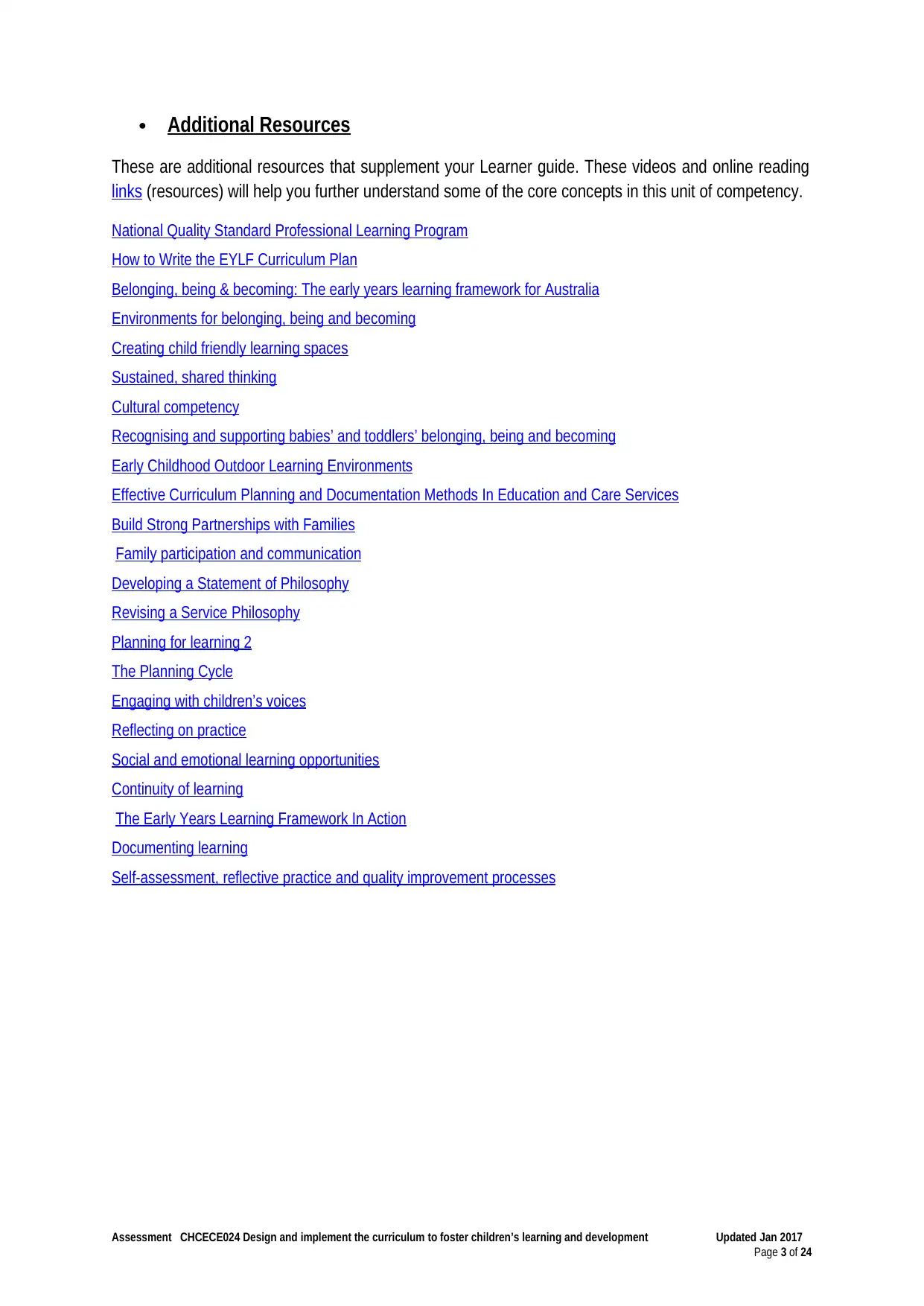
Additional Resources
These are additional resources that supplement your Learner guide. These videos and online reading
links (resources) will help you further understand some of the core concepts in this unit of competency.
National Quality Standard Professional Learning Program
How to Write the EYLF Curriculum Plan
Belonging, being & becoming: The early years learning framework for Australia
Environments for belonging, being and becoming
Creating child friendly learning spaces
Sustained, shared thinking
Cultural competency
Recognising and supporting babies’ and toddlers’ belonging, being and becoming
Early Childhood Outdoor Learning Environments
Effective Curriculum Planning and Documentation Methods In Education and Care Services
Build Strong Partnerships with Families
Family participation and communication
Developing a Statement of Philosophy
Revising a Service Philosophy
Planning for learning 2
The Planning Cycle
Engaging with children’s voices
Reflecting on practice
Social and emotional learning opportunities
Continuity of learning
The Early Years Learning Framework In Action
Documenting learning
Self-assessment, reflective practice and quality improvement processes
Assessment CHCECE024 Design and implement the curriculum to foster children’s learning and development Updated Jan 2017
Page 3 of 24
These are additional resources that supplement your Learner guide. These videos and online reading
links (resources) will help you further understand some of the core concepts in this unit of competency.
National Quality Standard Professional Learning Program
How to Write the EYLF Curriculum Plan
Belonging, being & becoming: The early years learning framework for Australia
Environments for belonging, being and becoming
Creating child friendly learning spaces
Sustained, shared thinking
Cultural competency
Recognising and supporting babies’ and toddlers’ belonging, being and becoming
Early Childhood Outdoor Learning Environments
Effective Curriculum Planning and Documentation Methods In Education and Care Services
Build Strong Partnerships with Families
Family participation and communication
Developing a Statement of Philosophy
Revising a Service Philosophy
Planning for learning 2
The Planning Cycle
Engaging with children’s voices
Reflecting on practice
Social and emotional learning opportunities
Continuity of learning
The Early Years Learning Framework In Action
Documenting learning
Self-assessment, reflective practice and quality improvement processes
Assessment CHCECE024 Design and implement the curriculum to foster children’s learning and development Updated Jan 2017
Page 3 of 24
⊘ This is a preview!⊘
Do you want full access?
Subscribe today to unlock all pages.

Trusted by 1+ million students worldwide
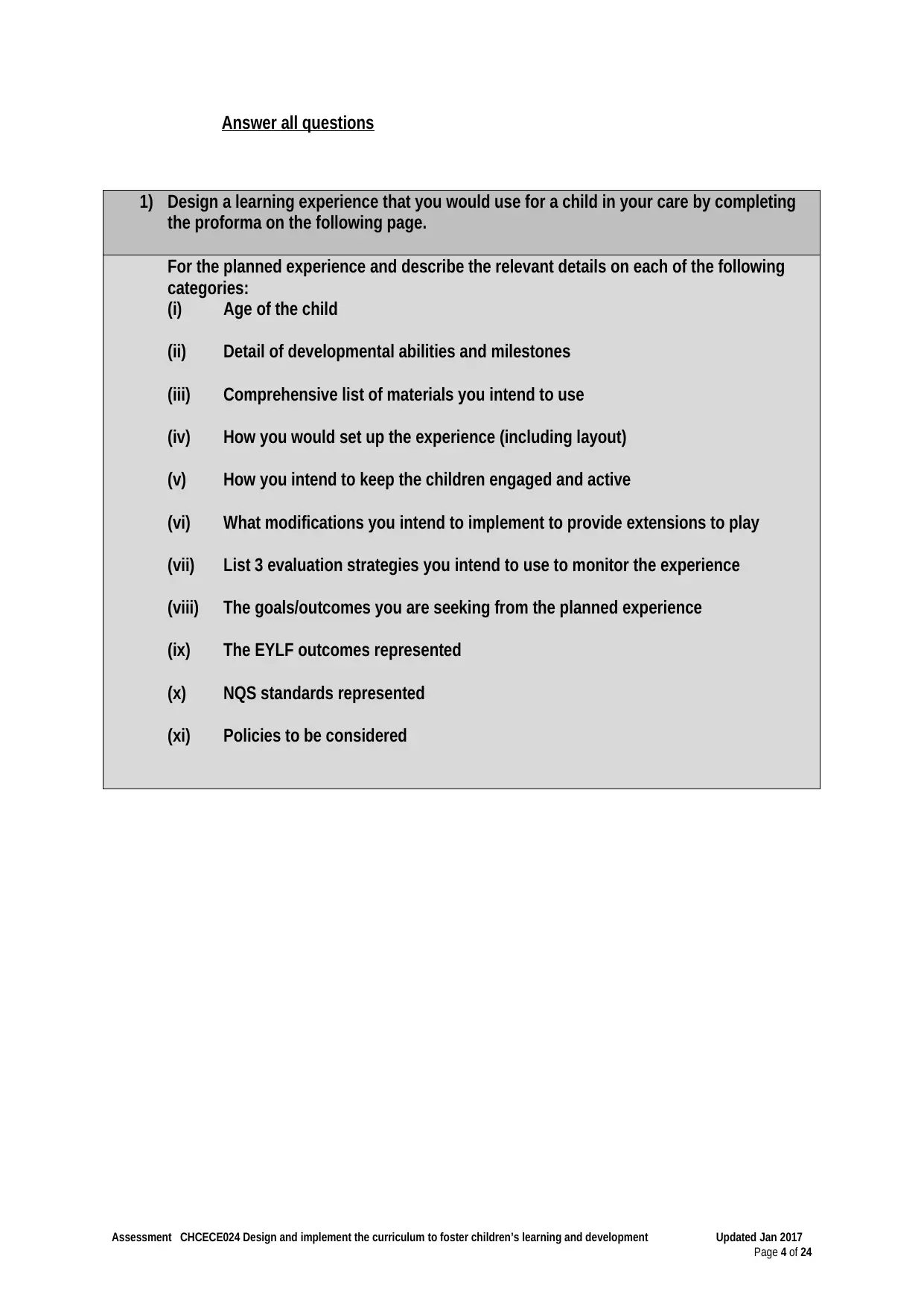
Answer all questions
1) Design a learning experience that you would use for a child in your care by completing
the proforma on the following page.
For the planned experience and describe the relevant details on each of the following
categories:
(i) Age of the child
(ii) Detail of developmental abilities and milestones
(iii) Comprehensive list of materials you intend to use
(iv) How you would set up the experience (including layout)
(v) How you intend to keep the children engaged and active
(vi) What modifications you intend to implement to provide extensions to play
(vii) List 3 evaluation strategies you intend to use to monitor the experience
(viii) The goals/outcomes you are seeking from the planned experience
(ix) The EYLF outcomes represented
(x) NQS standards represented
(xi) Policies to be considered
Assessment CHCECE024 Design and implement the curriculum to foster children’s learning and development Updated Jan 2017
Page 4 of 24
1) Design a learning experience that you would use for a child in your care by completing
the proforma on the following page.
For the planned experience and describe the relevant details on each of the following
categories:
(i) Age of the child
(ii) Detail of developmental abilities and milestones
(iii) Comprehensive list of materials you intend to use
(iv) How you would set up the experience (including layout)
(v) How you intend to keep the children engaged and active
(vi) What modifications you intend to implement to provide extensions to play
(vii) List 3 evaluation strategies you intend to use to monitor the experience
(viii) The goals/outcomes you are seeking from the planned experience
(ix) The EYLF outcomes represented
(x) NQS standards represented
(xi) Policies to be considered
Assessment CHCECE024 Design and implement the curriculum to foster children’s learning and development Updated Jan 2017
Page 4 of 24
Paraphrase This Document
Need a fresh take? Get an instant paraphrase of this document with our AI Paraphraser
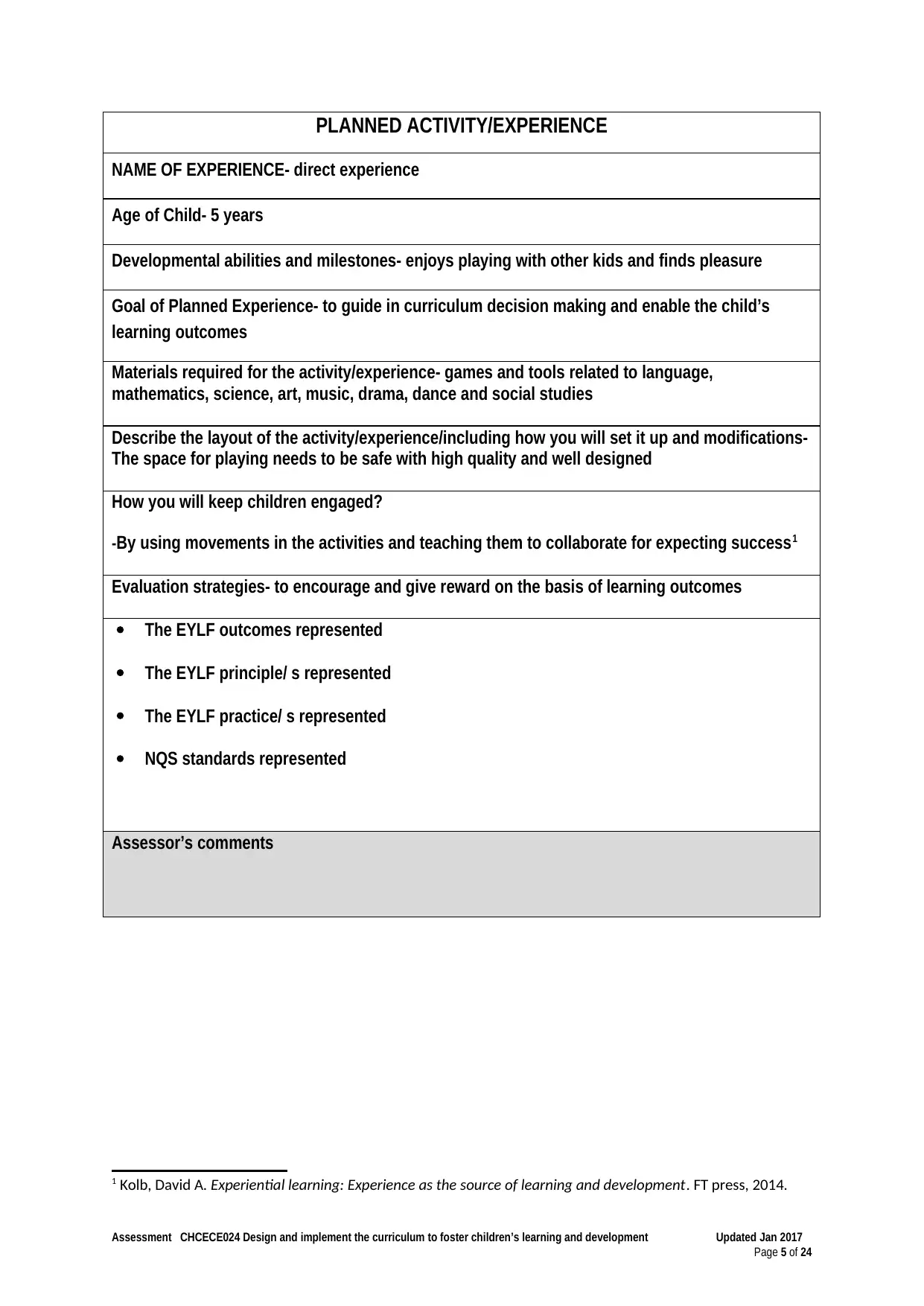
PLANNED ACTIVITY/EXPERIENCE
NAME OF EXPERIENCE- direct experience
Age of Child- 5 years
Developmental abilities and milestones- enjoys playing with other kids and finds pleasure
Goal of Planned Experience- to guide in curriculum decision making and enable the child’s
learning outcomes
Materials required for the activity/experience- games and tools related to language,
mathematics, science, art, music, drama, dance and social studies
Describe the layout of the activity/experience/including how you will set it up and modifications-
The space for playing needs to be safe with high quality and well designed
How you will keep children engaged?
-By using movements in the activities and teaching them to collaborate for expecting success1
Evaluation strategies- to encourage and give reward on the basis of learning outcomes
The EYLF outcomes represented
The EYLF principle/ s represented
The EYLF practice/ s represented
NQS standards represented
Assessor’s comments
1 Kolb, David A. Experiential learning: Experience as the source of learning and development. FT press, 2014.
Assessment CHCECE024 Design and implement the curriculum to foster children’s learning and development Updated Jan 2017
Page 5 of 24
NAME OF EXPERIENCE- direct experience
Age of Child- 5 years
Developmental abilities and milestones- enjoys playing with other kids and finds pleasure
Goal of Planned Experience- to guide in curriculum decision making and enable the child’s
learning outcomes
Materials required for the activity/experience- games and tools related to language,
mathematics, science, art, music, drama, dance and social studies
Describe the layout of the activity/experience/including how you will set it up and modifications-
The space for playing needs to be safe with high quality and well designed
How you will keep children engaged?
-By using movements in the activities and teaching them to collaborate for expecting success1
Evaluation strategies- to encourage and give reward on the basis of learning outcomes
The EYLF outcomes represented
The EYLF principle/ s represented
The EYLF practice/ s represented
NQS standards represented
Assessor’s comments
1 Kolb, David A. Experiential learning: Experience as the source of learning and development. FT press, 2014.
Assessment CHCECE024 Design and implement the curriculum to foster children’s learning and development Updated Jan 2017
Page 5 of 24
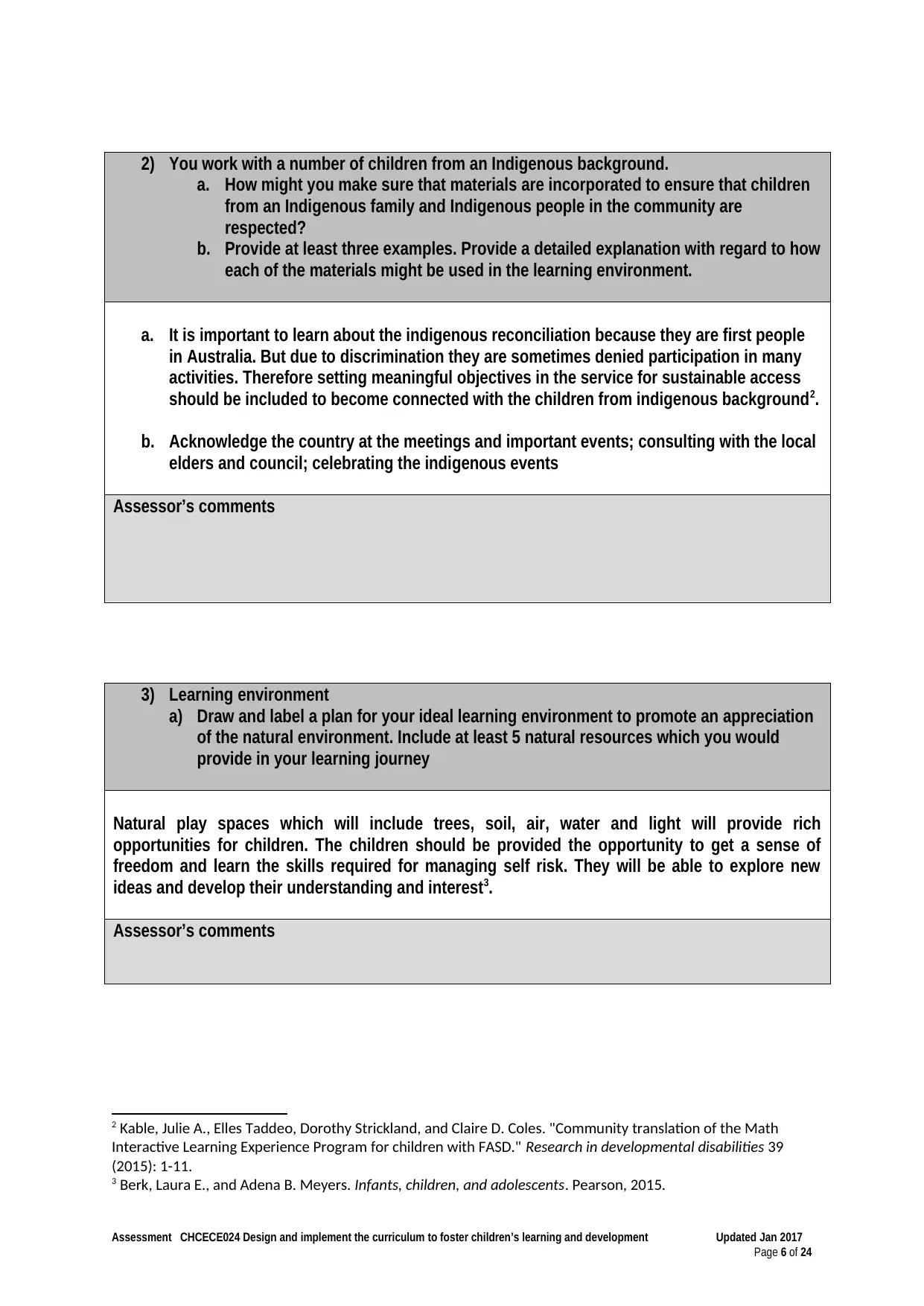
2) You work with a number of children from an Indigenous background.
a. How might you make sure that materials are incorporated to ensure that children
from an Indigenous family and Indigenous people in the community are
respected?
b. Provide at least three examples. Provide a detailed explanation with regard to how
each of the materials might be used in the learning environment.
a. It is important to learn about the indigenous reconciliation because they are first people
in Australia. But due to discrimination they are sometimes denied participation in many
activities. Therefore setting meaningful objectives in the service for sustainable access
should be included to become connected with the children from indigenous background2.
b. Acknowledge the country at the meetings and important events; consulting with the local
elders and council; celebrating the indigenous events
Assessor’s comments
3) Learning environment
a) Draw and label a plan for your ideal learning environment to promote an appreciation
of the natural environment. Include at least 5 natural resources which you would
provide in your learning journey
Natural play spaces which will include trees, soil, air, water and light will provide rich
opportunities for children. The children should be provided the opportunity to get a sense of
freedom and learn the skills required for managing self risk. They will be able to explore new
ideas and develop their understanding and interest3.
Assessor’s comments
2 Kable, Julie A., Elles Taddeo, Dorothy Strickland, and Claire D. Coles. "Community translation of the Math
Interactive Learning Experience Program for children with FASD." Research in developmental disabilities 39
(2015): 1-11.
3 Berk, Laura E., and Adena B. Meyers. Infants, children, and adolescents. Pearson, 2015.
Assessment CHCECE024 Design and implement the curriculum to foster children’s learning and development Updated Jan 2017
Page 6 of 24
a. How might you make sure that materials are incorporated to ensure that children
from an Indigenous family and Indigenous people in the community are
respected?
b. Provide at least three examples. Provide a detailed explanation with regard to how
each of the materials might be used in the learning environment.
a. It is important to learn about the indigenous reconciliation because they are first people
in Australia. But due to discrimination they are sometimes denied participation in many
activities. Therefore setting meaningful objectives in the service for sustainable access
should be included to become connected with the children from indigenous background2.
b. Acknowledge the country at the meetings and important events; consulting with the local
elders and council; celebrating the indigenous events
Assessor’s comments
3) Learning environment
a) Draw and label a plan for your ideal learning environment to promote an appreciation
of the natural environment. Include at least 5 natural resources which you would
provide in your learning journey
Natural play spaces which will include trees, soil, air, water and light will provide rich
opportunities for children. The children should be provided the opportunity to get a sense of
freedom and learn the skills required for managing self risk. They will be able to explore new
ideas and develop their understanding and interest3.
Assessor’s comments
2 Kable, Julie A., Elles Taddeo, Dorothy Strickland, and Claire D. Coles. "Community translation of the Math
Interactive Learning Experience Program for children with FASD." Research in developmental disabilities 39
(2015): 1-11.
3 Berk, Laura E., and Adena B. Meyers. Infants, children, and adolescents. Pearson, 2015.
Assessment CHCECE024 Design and implement the curriculum to foster children’s learning and development Updated Jan 2017
Page 6 of 24
⊘ This is a preview!⊘
Do you want full access?
Subscribe today to unlock all pages.

Trusted by 1+ million students worldwide
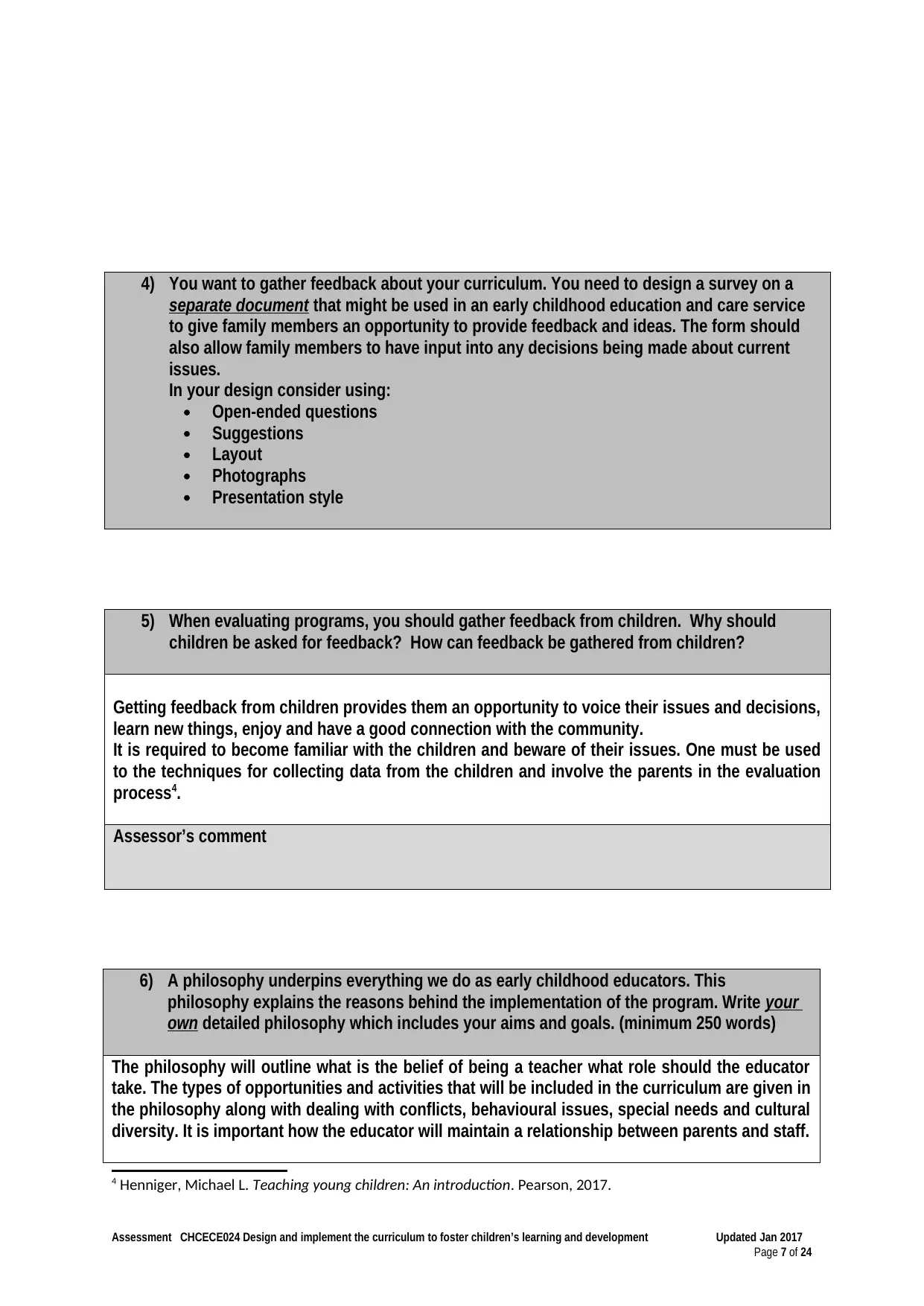
4) You want to gather feedback about your curriculum. You need to design a survey on a
separate document that might be used in an early childhood education and care service
to give family members an opportunity to provide feedback and ideas. The form should
also allow family members to have input into any decisions being made about current
issues.
In your design consider using:
Open-ended questions
Suggestions
Layout
Photographs
Presentation style
5) When evaluating programs, you should gather feedback from children. Why should
children be asked for feedback? How can feedback be gathered from children?
Getting feedback from children provides them an opportunity to voice their issues and decisions,
learn new things, enjoy and have a good connection with the community.
It is required to become familiar with the children and beware of their issues. One must be used
to the techniques for collecting data from the children and involve the parents in the evaluation
process4.
Assessor’s comment
6) A philosophy underpins everything we do as early childhood educators. This
philosophy explains the reasons behind the implementation of the program. Write your
own detailed philosophy which includes your aims and goals. (minimum 250 words)
The philosophy will outline what is the belief of being a teacher what role should the educator
take. The types of opportunities and activities that will be included in the curriculum are given in
the philosophy along with dealing with conflicts, behavioural issues, special needs and cultural
diversity. It is important how the educator will maintain a relationship between parents and staff.
4 Henniger, Michael L. Teaching young children: An introduction. Pearson, 2017.
Assessment CHCECE024 Design and implement the curriculum to foster children’s learning and development Updated Jan 2017
Page 7 of 24
separate document that might be used in an early childhood education and care service
to give family members an opportunity to provide feedback and ideas. The form should
also allow family members to have input into any decisions being made about current
issues.
In your design consider using:
Open-ended questions
Suggestions
Layout
Photographs
Presentation style
5) When evaluating programs, you should gather feedback from children. Why should
children be asked for feedback? How can feedback be gathered from children?
Getting feedback from children provides them an opportunity to voice their issues and decisions,
learn new things, enjoy and have a good connection with the community.
It is required to become familiar with the children and beware of their issues. One must be used
to the techniques for collecting data from the children and involve the parents in the evaluation
process4.
Assessor’s comment
6) A philosophy underpins everything we do as early childhood educators. This
philosophy explains the reasons behind the implementation of the program. Write your
own detailed philosophy which includes your aims and goals. (minimum 250 words)
The philosophy will outline what is the belief of being a teacher what role should the educator
take. The types of opportunities and activities that will be included in the curriculum are given in
the philosophy along with dealing with conflicts, behavioural issues, special needs and cultural
diversity. It is important how the educator will maintain a relationship between parents and staff.
4 Henniger, Michael L. Teaching young children: An introduction. Pearson, 2017.
Assessment CHCECE024 Design and implement the curriculum to foster children’s learning and development Updated Jan 2017
Page 7 of 24
Paraphrase This Document
Need a fresh take? Get an instant paraphrase of this document with our AI Paraphraser
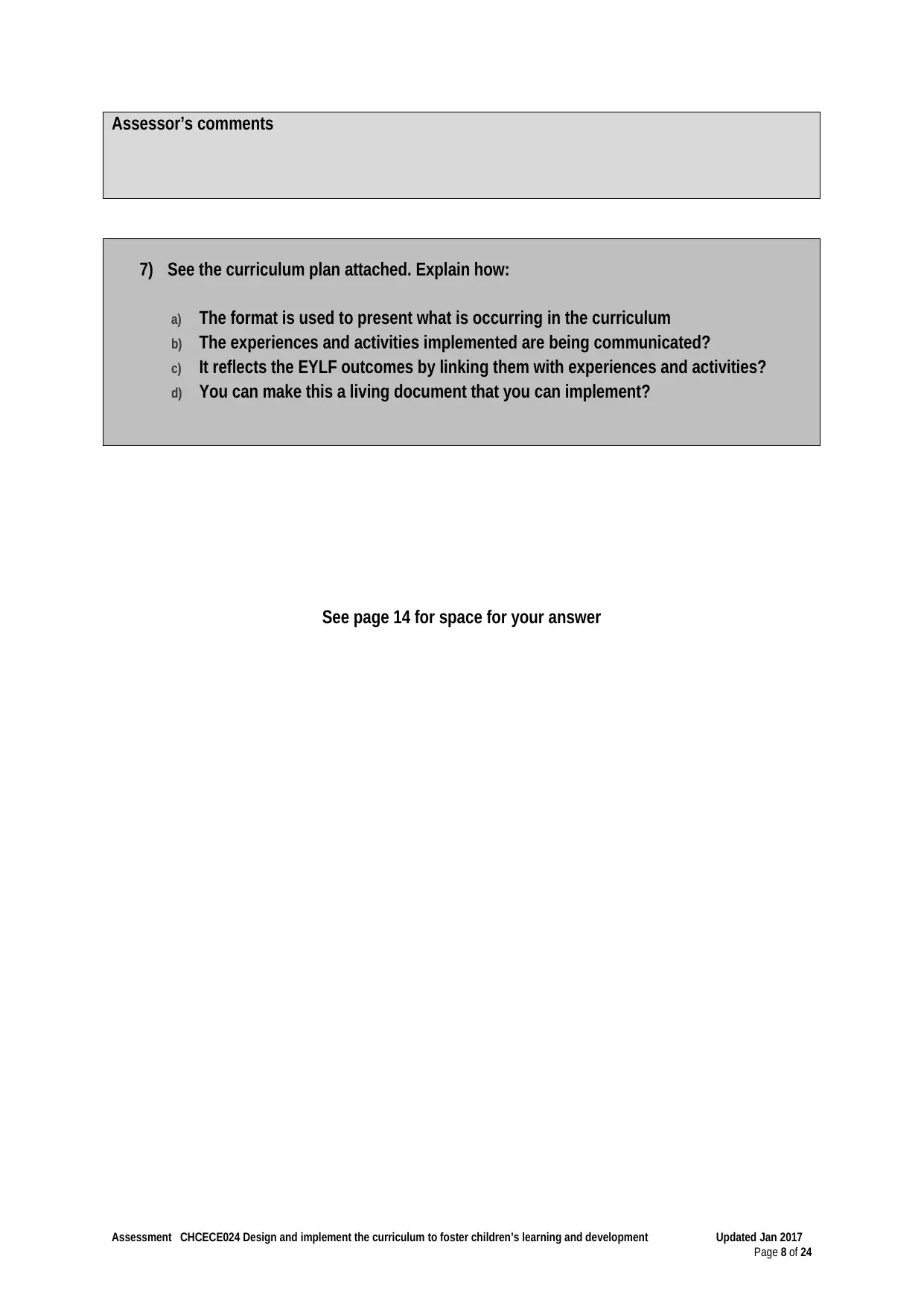
Assessor’s comments
7) See the curriculum plan attached. Explain how:
a) The format is used to present what is occurring in the curriculum
b) The experiences and activities implemented are being communicated?
c) It reflects the EYLF outcomes by linking them with experiences and activities?
d) You can make this a living document that you can implement?
See page 14 for space for your answer
Assessment CHCECE024 Design and implement the curriculum to foster children’s learning and development Updated Jan 2017
Page 8 of 24
7) See the curriculum plan attached. Explain how:
a) The format is used to present what is occurring in the curriculum
b) The experiences and activities implemented are being communicated?
c) It reflects the EYLF outcomes by linking them with experiences and activities?
d) You can make this a living document that you can implement?
See page 14 for space for your answer
Assessment CHCECE024 Design and implement the curriculum to foster children’s learning and development Updated Jan 2017
Page 8 of 24
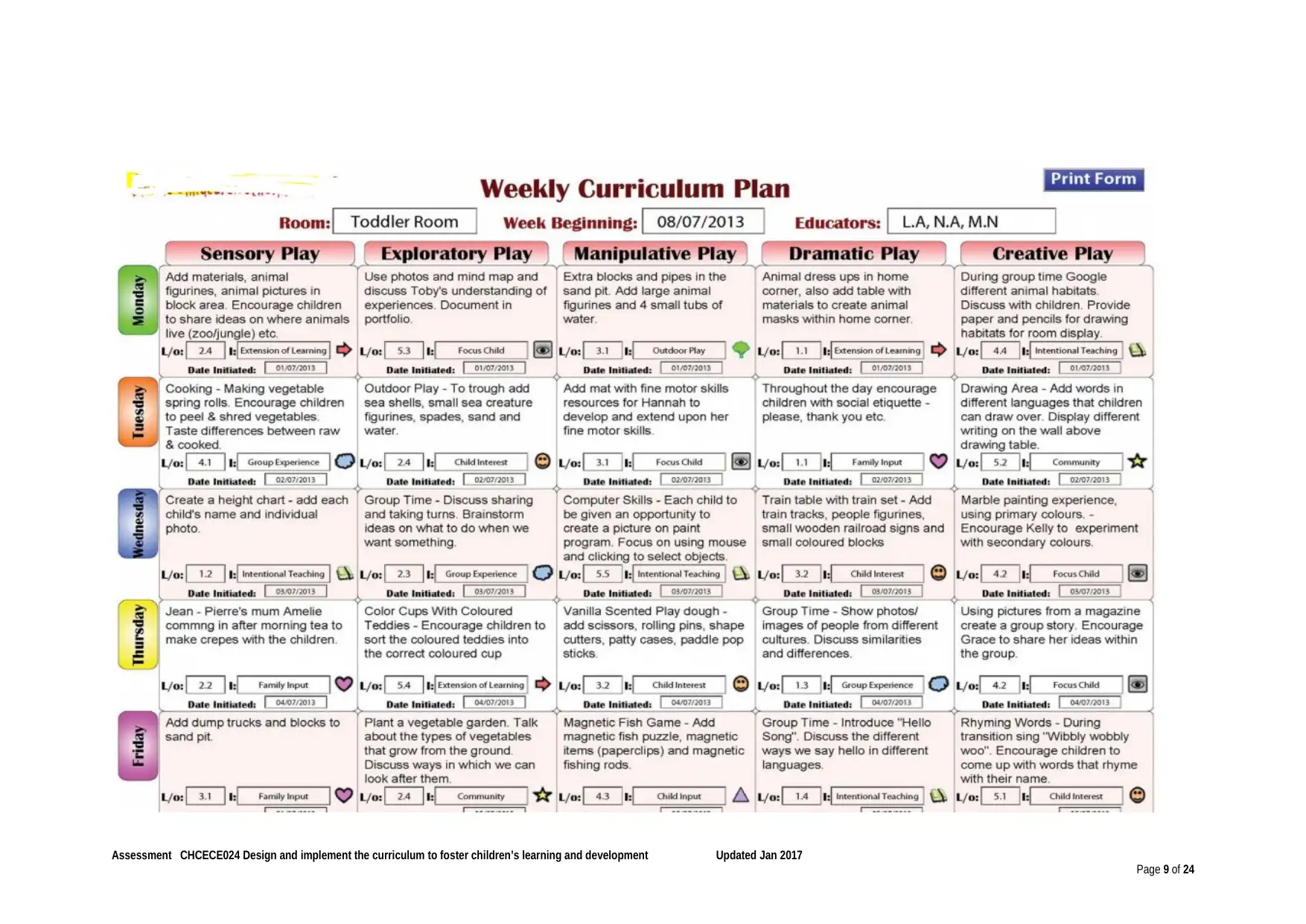
Assessment CHCECE024 Design and implement the curriculum to foster children’s learning and development Updated Jan 2017
Page 9 of 24
Page 9 of 24
⊘ This is a preview!⊘
Do you want full access?
Subscribe today to unlock all pages.

Trusted by 1+ million students worldwide
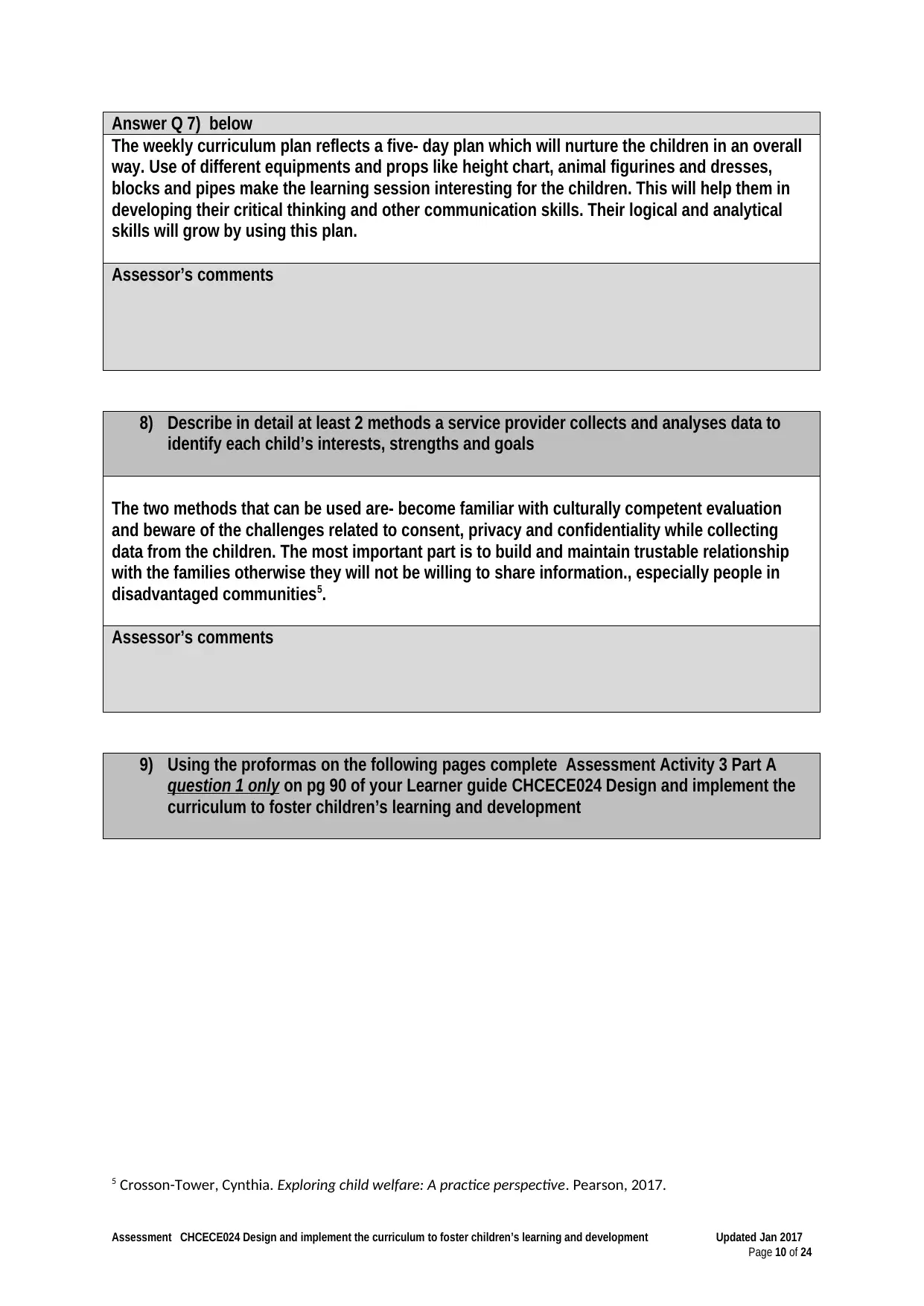
Answer Q 7) below
The weekly curriculum plan reflects a five- day plan which will nurture the children in an overall
way. Use of different equipments and props like height chart, animal figurines and dresses,
blocks and pipes make the learning session interesting for the children. This will help them in
developing their critical thinking and other communication skills. Their logical and analytical
skills will grow by using this plan.
Assessor’s comments
8) Describe in detail at least 2 methods a service provider collects and analyses data to
identify each child’s interests, strengths and goals
The two methods that can be used are- become familiar with culturally competent evaluation
and beware of the challenges related to consent, privacy and confidentiality while collecting
data from the children. The most important part is to build and maintain trustable relationship
with the families otherwise they will not be willing to share information., especially people in
disadvantaged communities5.
Assessor’s comments
9) Using the proformas on the following pages complete Assessment Activity 3 Part A
question 1 only on pg 90 of your Learner guide CHCECE024 Design and implement the
curriculum to foster children’s learning and development
5 Crosson-Tower, Cynthia. Exploring child welfare: A practice perspective. Pearson, 2017.
Assessment CHCECE024 Design and implement the curriculum to foster children’s learning and development Updated Jan 2017
Page 10 of 24
The weekly curriculum plan reflects a five- day plan which will nurture the children in an overall
way. Use of different equipments and props like height chart, animal figurines and dresses,
blocks and pipes make the learning session interesting for the children. This will help them in
developing their critical thinking and other communication skills. Their logical and analytical
skills will grow by using this plan.
Assessor’s comments
8) Describe in detail at least 2 methods a service provider collects and analyses data to
identify each child’s interests, strengths and goals
The two methods that can be used are- become familiar with culturally competent evaluation
and beware of the challenges related to consent, privacy and confidentiality while collecting
data from the children. The most important part is to build and maintain trustable relationship
with the families otherwise they will not be willing to share information., especially people in
disadvantaged communities5.
Assessor’s comments
9) Using the proformas on the following pages complete Assessment Activity 3 Part A
question 1 only on pg 90 of your Learner guide CHCECE024 Design and implement the
curriculum to foster children’s learning and development
5 Crosson-Tower, Cynthia. Exploring child welfare: A practice perspective. Pearson, 2017.
Assessment CHCECE024 Design and implement the curriculum to foster children’s learning and development Updated Jan 2017
Page 10 of 24
Paraphrase This Document
Need a fresh take? Get an instant paraphrase of this document with our AI Paraphraser
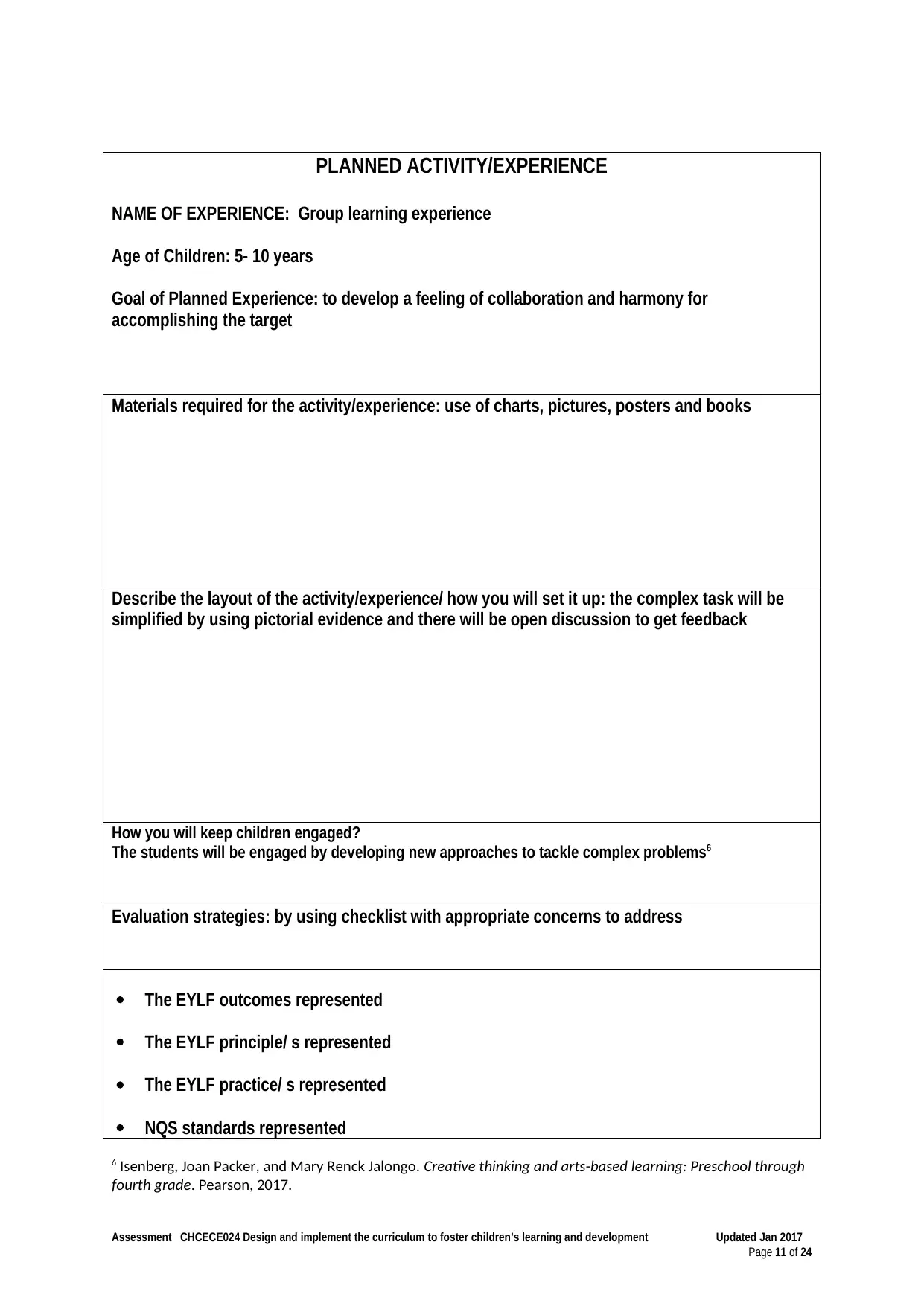
PLANNED ACTIVITY/EXPERIENCE
NAME OF EXPERIENCE: Group learning experience
Age of Children: 5- 10 years
Goal of Planned Experience: to develop a feeling of collaboration and harmony for
accomplishing the target
Materials required for the activity/experience: use of charts, pictures, posters and books
Describe the layout of the activity/experience/ how you will set it up: the complex task will be
simplified by using pictorial evidence and there will be open discussion to get feedback
How you will keep children engaged?
The students will be engaged by developing new approaches to tackle complex problems6
Evaluation strategies: by using checklist with appropriate concerns to address
The EYLF outcomes represented
The EYLF principle/ s represented
The EYLF practice/ s represented
NQS standards represented
6 Isenberg, Joan Packer, and Mary Renck Jalongo. Creative thinking and arts-based learning: Preschool through
fourth grade. Pearson, 2017.
Assessment CHCECE024 Design and implement the curriculum to foster children’s learning and development Updated Jan 2017
Page 11 of 24
NAME OF EXPERIENCE: Group learning experience
Age of Children: 5- 10 years
Goal of Planned Experience: to develop a feeling of collaboration and harmony for
accomplishing the target
Materials required for the activity/experience: use of charts, pictures, posters and books
Describe the layout of the activity/experience/ how you will set it up: the complex task will be
simplified by using pictorial evidence and there will be open discussion to get feedback
How you will keep children engaged?
The students will be engaged by developing new approaches to tackle complex problems6
Evaluation strategies: by using checklist with appropriate concerns to address
The EYLF outcomes represented
The EYLF principle/ s represented
The EYLF practice/ s represented
NQS standards represented
6 Isenberg, Joan Packer, and Mary Renck Jalongo. Creative thinking and arts-based learning: Preschool through
fourth grade. Pearson, 2017.
Assessment CHCECE024 Design and implement the curriculum to foster children’s learning and development Updated Jan 2017
Page 11 of 24
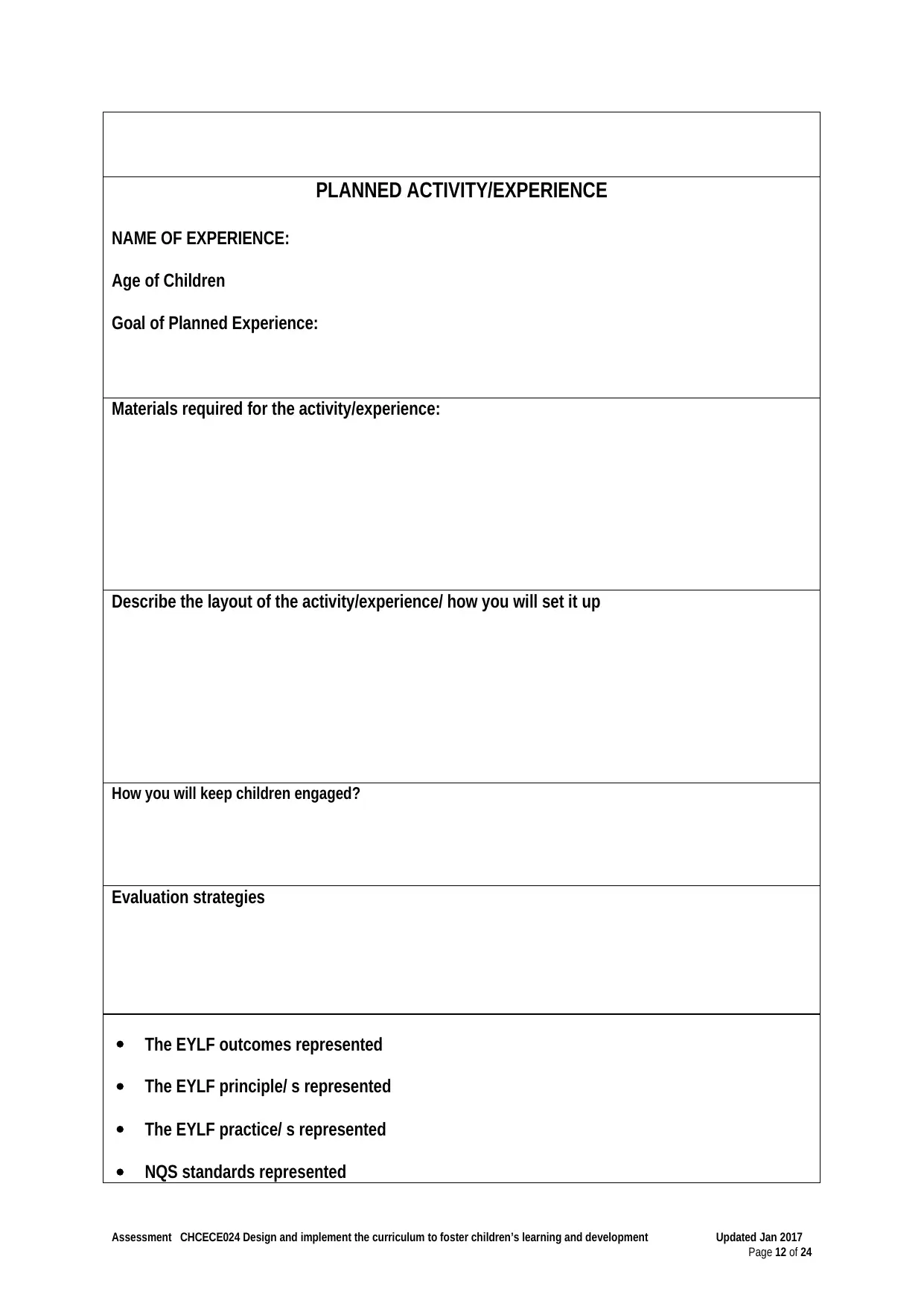
PLANNED ACTIVITY/EXPERIENCE
NAME OF EXPERIENCE:
Age of Children
Goal of Planned Experience:
Materials required for the activity/experience:
Describe the layout of the activity/experience/ how you will set it up
How you will keep children engaged?
Evaluation strategies
The EYLF outcomes represented
The EYLF principle/ s represented
The EYLF practice/ s represented
NQS standards represented
Assessment CHCECE024 Design and implement the curriculum to foster children’s learning and development Updated Jan 2017
Page 12 of 24
NAME OF EXPERIENCE:
Age of Children
Goal of Planned Experience:
Materials required for the activity/experience:
Describe the layout of the activity/experience/ how you will set it up
How you will keep children engaged?
Evaluation strategies
The EYLF outcomes represented
The EYLF principle/ s represented
The EYLF practice/ s represented
NQS standards represented
Assessment CHCECE024 Design and implement the curriculum to foster children’s learning and development Updated Jan 2017
Page 12 of 24
⊘ This is a preview!⊘
Do you want full access?
Subscribe today to unlock all pages.

Trusted by 1+ million students worldwide
1 out of 24
Related Documents
Your All-in-One AI-Powered Toolkit for Academic Success.
+13062052269
info@desklib.com
Available 24*7 on WhatsApp / Email
![[object Object]](/_next/static/media/star-bottom.7253800d.svg)
Unlock your academic potential
Copyright © 2020–2025 A2Z Services. All Rights Reserved. Developed and managed by ZUCOL.





